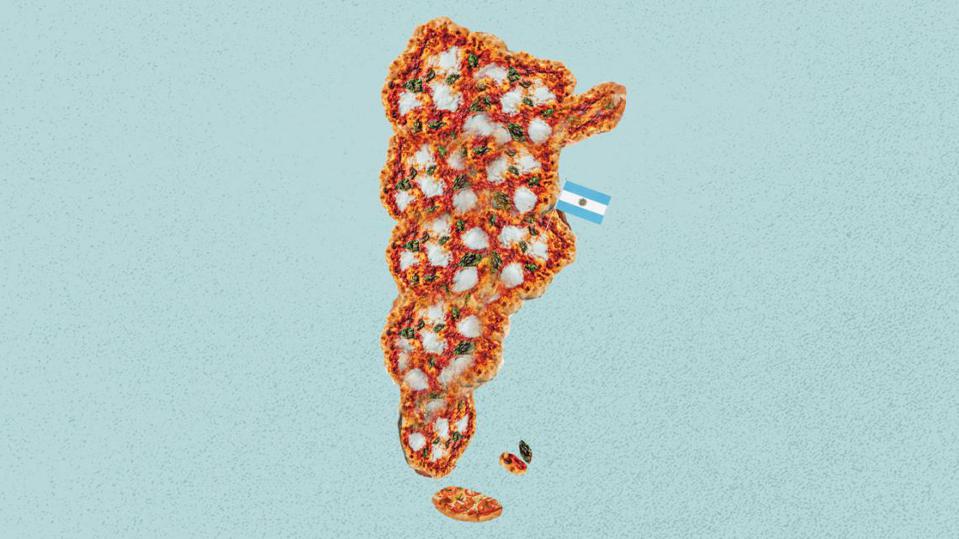The first time you try to order a pizza in Buenos Aires you’ll realize that pizza, like many other things in Argentina, is just a little bit different.
As a self-proclaimed pizza connoisseur, I am here to give you the breakdown:
4 most popular Salsas (Pizza Sauces):
Where I come from (the United States), there is just one kind of sauce. Pizza sauce. But here there are a few different kinds whose names do little to describe the contents:
Salsa de tomate:
First up is the traditional tomato based sauce- the only sauce I ever knew before coming to Buenos Aires. This is the delicious and “traditional” pizza sauce.
Salsa portuguesa:
This is a heartier tomato sauce made with bell peppers and onions and includes other herbs and seasonings such as parsley and oregano.
Salsa blanca:
Béchamel sauce. For those among us who don’t cook much (because we’re too busy ordering pizza!), Béchamel sauce is a mixture of milk, butter, and flour. Usually, use on Veggie pizza.
Salsa golf:
Essentially a mixture of mayonnaise and ketchup, along with other ingredients such as mustard to add more flavor. The story behind Salsa golf is that Nobel Laureate Luis Federico Leloir grew tired of being served prawns with mayonnaise and asked the waiter to bring him other condiments. Being the gifted chemist that he was, he mixed up this sauce at the famous Golf Club in Mar del Plata (a resort city south of Buenos Aires), the place from which the sauce now derives its name.

5 most popular Quesos (Cheeses)
There are a few options, but 95% of the time you’ll find yourself with the cheese at the top of my list:
Mozzarella:
the most popular cheese (for obvious reasons) – you might see a few different spellings, but this is by far what you’re the most likely to encounter.
Queso – this is short for “Queso cremoso” – a creamy cheese (not to be confused with cream cheese!) that is simple and is the most commonly found type of cheese down here (outside of a pizza parlor, anyway).
Roquefort:
this is a type of blue cheese; most places offer a Roquefort pizza and some places also offer roquefort empanadas.
Provolone:
Just like the roquefort, many places have a provolone pizza on hand.
En hebras:
This last one means that the cheese is shredded.
3 most popular Masas (Crusts)
Just like in the states, there are a few basic types:
A la piedra:
Thin crust pizza
De molde:
A thick crust pizza, up to 2 cm (almost 1 inch) thick
Media masa:
This is somewhere between “a la piedra” and “de molde” with regards to thickness, and is what you are more likely to find in a supermarket.
10 most common Ingredientes (Toppings)
There are plenty of toppings that we have in common, but I find here that they tend to have a list of pizza recipes with a set combination of toppings. While you can always add toppings, you can’t really “make-you-own” the way you might back home. Here are some familiar and less-familiar toppings you’re likely to encounter:
Aceitunas:
Unless “negras” (black) are specified, these will be green olives. It’s a 50/50 chance that they’ll have pits depending on where you go. If you don’t like pits, proceed with caution.
Albahaca:
Fresh basil leaves are placed on the pizza (after its cooked) to give it a great flavor.
Arúcula:
Fresh arugula is also a common post-oven topping.
Palmitos:
Palm hearts – Typically sliced up into little bite-size pieces, they go great and can be found on pizzas all over the city.
Huevos:
Hard-boiled eggs are shredded and sprinkled on top of the pizza.
Humitas:
(you may also see “choclo”) – this is corn – not as common on a pizza, but very common as an empanada.
Morrónes:
The local word for peppers, they take long slices of cooked (usually red) peppers and put them on the pizza rather than chopped up slices of raw peppers.
Jamón:
This is a very popular pizza topping all around the world, but down here then tend to put on a whole slice of ham rather than smaller pieces.
Jamón crudo:
Literally “raw ham” also known as Prosciutto- salted, cured, bite-size slices
Fugazza and Fugazzeta
These are an Argentine curiosity. Fugazza is a layer of onions laid on top of a pizza crust, while Fugazzeta is onions, pizza crust, a thick bed of melted cheese. Some people are a little put off by so much onion, but I think it’s great.






